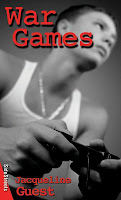A Brief History of Kids’ Lit – the 21st century
Only 16 years into the new millenium, the direction of
kids’ literature has yet to be clearly charted but so far are a few things are clear.
There are few topics that kids’ literature doesn’t dare to tackle. In the past
decade, topics have covered such controversial subjects as suicide, gender
identify, bullying, self-harm, dysfunctional family life, and – most notably – dystopian
themes.
It’s this genre that’s gained the rapt attention of
pre-teen and teenage audiences. There are some books in this theme aimed at
younger kids (e.g., Dr Seuss’ The Lorax, The Flower by John Light). But dystopian lit has especially
captured the attention of slightly older readers, addressing futuristic topics
like genetic engineering (e.g., cloning in Replica, 2015), bioethics,
environmental degradation, life in totalitarian states (e.g., The Hunger Games triology).
The
Rise in Dystopian Lit
Dystopian lit bubbled to the surface in the mid-20th
century with a few titles, like George Orwell’s 1984 (1949), Williams Golding’s
The Lord of the Flies (1954), and Kurt Vonnegut’s short story, Harrison
Bergeron (1961). Orwell’s 1984 remains on the best-seller list of books in this
genre to this day. But in the libraries of today’s young readers, dystopian lit
takes up the majority of shelf space.
What is meant by “dystopian lit”? A dystopia is
an imagined place in which everything is unpleasant, the story typically set in
an environmentally degraded state and/or under the influence of a corrupt,
totalitarian government that oppresses the masses. Realistic yet
fictional, with direct comparisons to real world events, the relativity of the
real world from a teenage perspective was first introduced by Lois Lowry’s The
Giver (1993). Many 21st centure titles in this genre have a female
as the strong, masculine-like protagonist, in an effort to make the story
relatable to both genders (Hunger Games series, Divergent series, Revealing
Eden, Across the Universe).
 |
| Reading Wolf (Canadian Animal series), V. Lawton |
Authors of dystopian lit write both to entertain readers, and to ask them to
compare and contrast the ideas and characteristics in the real world with those
of a dyfunctional one. It seems that the bleaker the environment, the greater
the interest on the part of the reader.
Dystopian lit is usually meant as a cautionary tale
in which the author warns readers of something in society, some trend or set of
values that’s dangerous. It’s also intended to provide hope for a different
and more humane world.
Why the current fascination with dystopian lit? Some
attribute the mid-20th century interest in dystopian lit as a
response to the Cold War. Perhaps the late 20th century/21st
century interest can be attributed to the rise in social media and
communication technology… is the pervasiveness of social media the ominscient
Big Brother, everpresent-- watching who we like, what we buy, what we think,
what we post online?
Next blog post – getting the
reluctant reader in your household interested in books.


Comments
شركة مكافحه حشرات بالقصيم
شركة مكافحة حشرات بالدمام
شركة مكافحة حشرات ببريده
شركة مكافحة حشرات بالاحساء